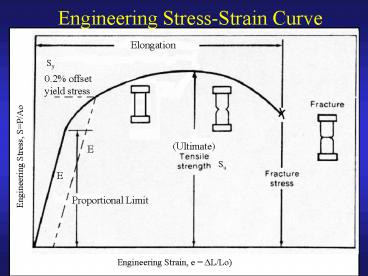Engineering StressStrain Curve - PowerPoint PPT Presentation
1 / 22
Title:
Engineering StressStrain Curve
Description:
Mech422 - Stress and Strain Analysis - F2002. Quick Tip! ... shear strain, g = angle of deformation (radians) shear modulus, G = t /g (elastic region) ... – PowerPoint PPT presentation
Number of Views:459
Avg rating:3.0/5.0
Title: Engineering StressStrain Curve
1
Engineering Stress-Strain Curve
Elongation
Sy
0.2 offset yield stress
Engineering Stress, SP/Ao
(Ultimate)
E
Su
E
Proportional Limit
Engineering Strain, e DL/Lo)
2
Post Yield Stress-Strain Material Behaviour
3
Quick Tip!
- Express Load in Newtons (N) and Area in mm2 to
get Stress in MPa. - Mechanical properties of engineering materials
are almost always given in MPa or ksi. - Imperial units Load in kips (1000 lbf) Area as
in2 gives Stress in ksi (kips/in2) - 1000 psi 1 ksi 6.89 MPa
4
Hookes Law Elastic Deformation
- Elastic deformation is not permanent it means
that when the load is removed, the part returns
to its original shape and dimensions. - For most metals, the elastic region is linear.
For some materials, including metals such as cast
iron, polymers, and concrete, the elastic region
is non-linear. - If the behavior is linear elastic, or nearly
linear-elastic, Hookes Law may be applied - Where E is the modulus of elasticity (MPa)
5
Modulus of Elasticity - Stiffness
6
Atomic Origin of Stiffness
7
Shear Stress and Strain
Shear Stress
Shear Strain
shear stress, t Shear Load / Area shear strain,
g angle of deformation (radians) shear modulus,
G t /g (elastic region)
8
Elastic Properties of Materials
- Poissons ratio When a metal is strained in one
direction, there are corresponding strains in all
other directions. - For a uniaxial tension strain, the lateral
strains are constrictive. - Conversely, for a uniaxial compressive strain,
the lateral strains are expansive. - i.e. the lateral strains are opposite in sign to
the axial strain. - The ratio of lateral to axial strains is known as
Poissons ratio, n.
9
Poissons Ratio, n
For most metals, 0.25 lt n lt 0.35 in the elastic
range
Furthermore
10
Plastic Deformation
Sy
Sy
Sy
Stress
Strain
0.002
0.002
0.002
Most Metals - Al, Cu
Clad Al-Alloys
Low carbon Steel
11
Microstructural Origins of Plasticity
- Slip, Climb and Slide of atoms in the crystal
structure. - Slip and Climb occur at Dislocations and Slide
occurs at Grain Boundaries.
t
t
12
Elastic and Plastic Strain
P
(e,S)
Stress
Total Strain
The 0.2 offset yield stress is the stress that
gives a plastic (permanent) strain of 0.002.
Strain
Plastic
Elastic
ee
ep
13
Elastic Recovery
Loading
Loading
Reloading
Stress
Unloading
Unloading
Strain
Strain
elastic strain
14
Ductile Vs Brittle Materials
- Only Ductile materials will exhibit necking.
- Ductile if ELgt8 (approximately)
- Brittle if EL lt 5 (approximately)
Engineering Stress
Engineering Strain
15
Typical Mechanical Properties
Metals in annealed (soft) condition
16
True Stress and True Strain
- True stress, s, is the load, P, divided by the
instantaneous area of the specimen, Ai. - True strain, e, is determined from the rate of
change in gauge length with respect to the
instantaneous gauge length, Li. - When strains are elastic, Ss, and ee.
- Up to strain where necking begins, specimen
deforms with a constant volume in gauge section. - Constant Volume gives
17
True Stress
Assumes constant volume. Valid for all strains up
to point where necking begins Hence, valid for
S lt Su.
Special Case, True Fracture Stress
18
True Strain
Assumes constant volume. Valid for all strains up
to point where necking begins Hence, valid for
S lt Su.
Special Case, True Fracture Strain
19
Engineering Vs. True Stress-Strain Curves
20
Equation of s-e curve
K
fracture
Log(true stress, s) MPa
n
necking
1.0
0.10
0.010
0.0010
Log(true plastic strain, ep)
21
Ramberg-Osgood Equation
22
Typical K and n values for metals
K Strain hardening coefficient n Strain
hardening exponent































